I confess it hasn’t been a quick process, but my take on Boogiepop wa Warawanai has evolved from bemused detachment to genuine engagement. That engagement is still almost entirely intellectual and not emotional, but it’s there and that counts for something – a lot in fact. While there are obvious reasons for all that, most obviously that the series itself is rather intellectual and detached (as was the norm for sci-fi anime at the time it originally made the jump to the screen), I think the approach one takes to viewing it matters too.
What strikes me after five weeks and six episodes is that Boogiepop is narratively like a body of water covered by whirlpools which are constantly on the move. They’re not the violent kind that suck you under and drown you, but gently eddying ones. Sometimes they intersect briefly, and they all revolve around the one in the center which is the only one which doesn’t move – Boogiepop himself. As a viewer you can fight against them and be confused and disoriented, but when you make the decision to lie back and let them take you where they will, the experience becomes far more pleasant – even transcendent, like meditation.
I must say, I respect that Natsume Shingo and Suzuki Tomohiro – tenured veterans and sure hands at the tiller – have been so unrelenting in preserving the essential nature of Boogiepop. There’s no contemporizing for modern tastes here – they’ve stayed with the series’ anachronistic style, recognizing that it’s intrinsic to the show’s nature. I’m sure they’re losing a chunk of the modern audience in doing so, but given Boogiepop’s symbolic importance in media history (it was among the first true light novels and probably the first ever adapted to anime) it would be a crying shame if that essential nature were changed to try and suit the times.
Another revelation which hit me this week as a new viewer is that Boogiepop’s essential conceit seems to be this: what if all the bugbears of adolescent urban legend were actually real? That’s not a totally unique concept in itself, but the treatment it gets here is interesting – the series treats adolescent mythology (which is symbolic of the psychological turbulence Suema talks about) literally, then uses the literal events in symbolic fashion as commentary on adolescence. It’s actually brilliant in its way – the circle loops back on itself.
Of the many whirlpools we’ve floated on in the first six eps, the one featuring Aya and Masaki strikes me as being just a bit different. This one (for me at least) is the emotional center of Boogiepop wa Warawanai – more overtly appealing to the heart than the others. We know this one has overlapped with the Jin and Anou pools, and Suema’s drifts into view for the first time in several weeks. That it’s Boogiepop she’s tutoring as we meet her this week is no coincidence – again, Boogiepop is at the center, but also at the periphery. When important events are about to happen, that’s when Boogiepop appears.
As Aya is being threatened and abused by Creepy E, Masaki stumbles upon them and tries to intervene. He wasn’t kidding when he said he was a martial arts expert, but that’s of little avail against Creepy. Aya obviously has feelings for him, which is just as obviously forbidden for her. Whether she was able to successfully prevent Creepy E from doing Masaki permanent damage is less clear, though when he awakes sans his memories of the clash he seems perfectly normal apart from their absence. Eventually Suema becomes involved when Aya turns up on the school roof about to commit suicide (the prominence of suicide in this series in a country where teen suicide has been a huge problem for decades is no coincidence). Their conversation is the most revealing of the episode – peeling back the curtain a bit, if you will.
Meanwhile, Suema also intersects with the Jin whirlpool thanks to Kinukawa Kotoe (Asumi Kana), Jin’s cousin. She’s worried about the change in his behavior and has heard about Suema-san’s interest in weird stuff. Being a deviancy otaku (though more the psychology than the occult kind) she investigates – and in doing so, stumbles on a ritual where Jin indoctrinates two girls into the Imaginator’s army (why this involves them taking their tops and bras off is unclear). Jin (I wonder what happened with his father) is obviously a crucial nexus point for all this stories, and Boogiepop now having taking notice of him means a confrontation of some sort is going to happen there sooner or later.
As one steps back and considers all the distinct eddies in the plot, patterns start to become clear. The movement of these whirlpools isn’t random – as in nature, there’s an overarching logic to them that can be predictive if you work at it. Boogiepop wa Warawanai is still confusing – there are many characters (with roughly similar designs) and the way they pop in and out of the story makes it a challenge to tell all the players without a scorecard sometimes. That’s another reason why I find the Masaki-Aya thread a bit more emotionally appealing – it isn’t afraid to trade on relatable human feelings. He wants to protect her, and she him – and she blames herself for pulling him into dangerous waters. Being intellectually curious about where all these stories are headed is a good reason to watch, but actually caring about one of them makes the experience a bit more rewarding.


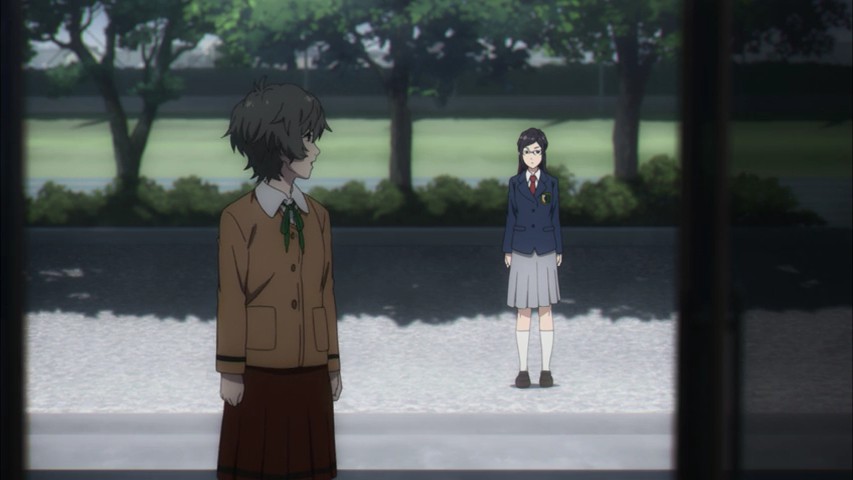
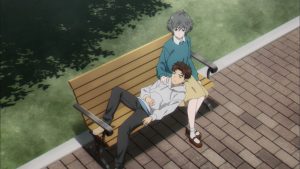
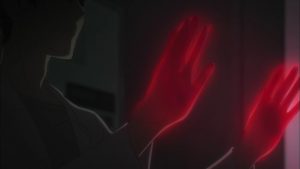


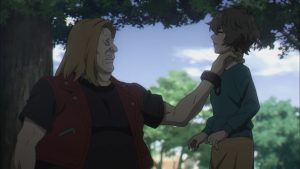
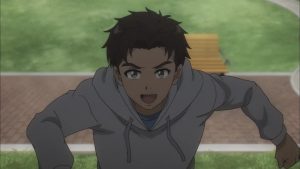

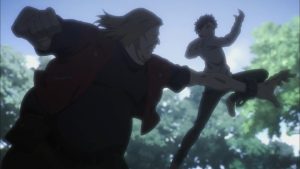
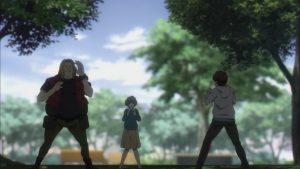
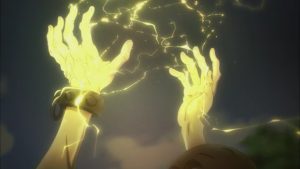
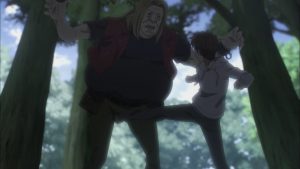

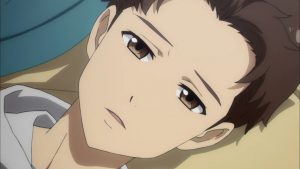
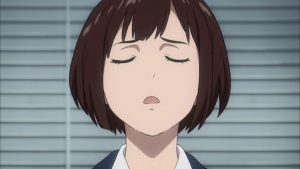
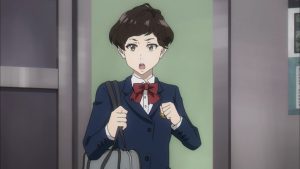
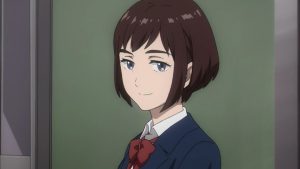
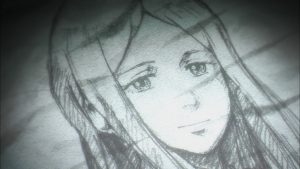

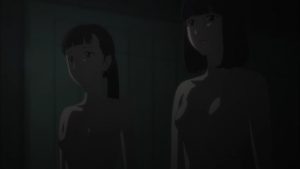
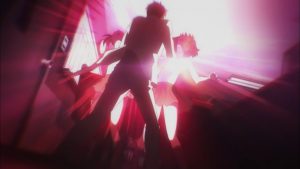

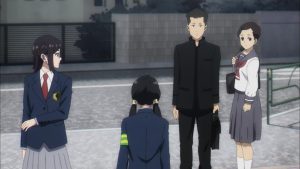
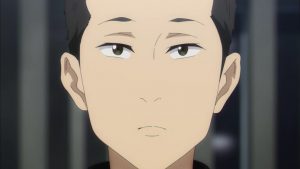
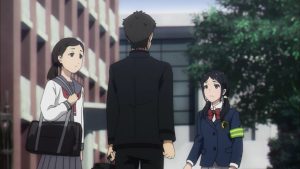
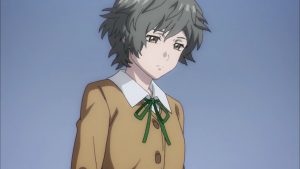

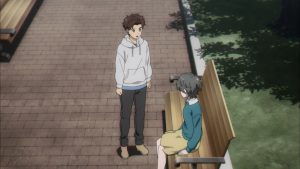
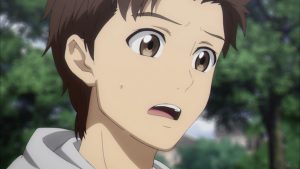

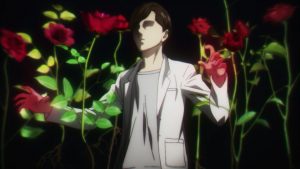
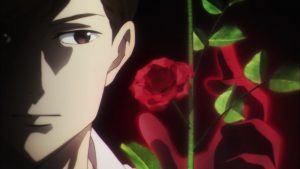
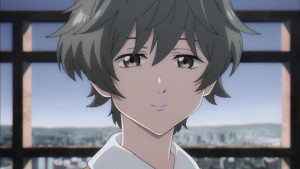

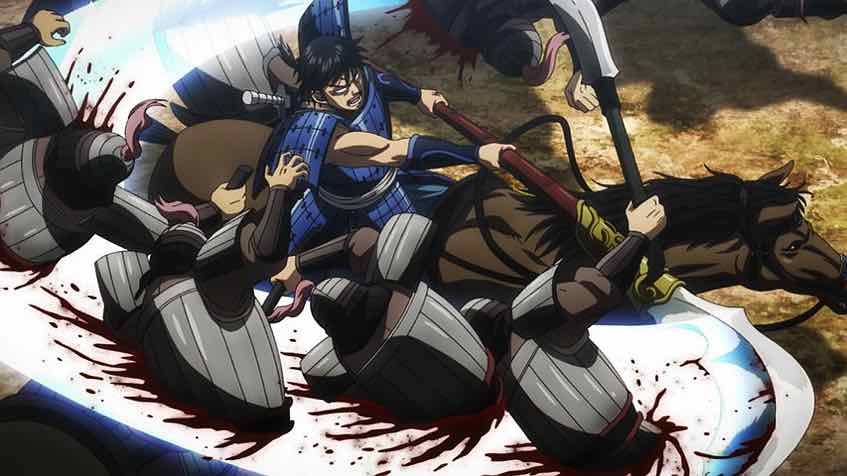

Jindujun93
February 2, 2019 at 6:38 pmAs a novel reader, due to the nature of Boogiepop’s narrative it’s going to be tough to comment, but I’ll try my best, because I genuinely do like the Imaginator arc.
First of all, your comparison to whirlpools and all that – it’s actually surprisingly accurate, even for the novels. Admittedly, in the novels it’s a bit easier to get along, because the narration also provides a lot of details that are absent from this adaption. I’ve already seen plenty of novel readers complain about this to varying degrees, but honestly? I think it’s fine (taking aside that the first novel was maybe compressed a bit too much). This was always the kind of title where I figured it’d be tough to translate it perfectly into anime, and for me, Shingo Natsume and his team are doing a good job so far. They DID implement a few changes (for example, Jin’s painting that Suema was looking at was actually a more abstract one in the novels), but I’m not bothered by them in the least.
Same goes for that section where Aya and Suema were talking at the roof, and it kept cutting to Aya’s conversation with Masaki about Boogiepop. In the novels, those were actually from two separate chapters (episode 4 already did something similar during the police hearing for Jin, though the drug addict encounter and the police hearing were in the same chapter, just not entangled like the anime did it), but here they mixed them together – and it’s actually a choice I really like and one of the benefits to adapting Boogiepop into an anime, as this is one of the unique advantages an anime has over the novels – it’s much easier to implement a scene like that here, and I tip my hat to them for that.
Another advantage this anime has so far is the voice acting – and man, does Yuuki Aoi nail it as Boogiepop (and Touka, too). We only need one brief moment to see when exactly Boogiepop took over – with Touka suddenly standing next to Kotoe despite being right next to Suema just a moment ago, and then that first voice line. Just perfect. I have Boogiepop’s voice from the old anime still in my head so I’m able to compare, and I think while I do like the old voice a lot, this one’s just even more fitting. This is one of those really good casting choices.
Currently we’re more or less at the halfway point – they adapted everything except for one shorter chapter from volume 2 in those last three episodes, and that chapter can be combined with events from volume 3 (vs Imaginator is a two-parter), so we’re on track so far. It’s interesting – despite actually covering a similar amount of ground in three episodes so far as the first three did, this time the anime just does it… a lot better. It helps that, as you mentioned, the story around Aya and Masaki is one of the more human ones of what I’ve read of Boogiepop so far (I was only able to read four volumes so far, I’ll finally be able to take a peek at vol 4+5 once they release in the West next week, but out of those four volumes that was easily one of my favorite aspects), and I’m glad that they’re hitting the key notes pretty well so far.
As a final question, out of mere curiousity (technically I have more to say, but I think I’ll wait with that until after episode 9 when you’ve seen the entire arc as to avoid potential spoilers by accident) – how much time do you think has passed since the arc has started, in-universe?
Guardian Enzo
February 2, 2019 at 7:48 pmFirst of all, your comparison to whirlpools and all that – it’s actually surprisingly accurate, even for the novels.
Left-handed compliment? 😉
First off yes, Aoi Yuuki is wonderful. She generally is but she’s so distinctive here – I just want to hear more of her. As for how long in the arc, do you mean specifically the Masaki-Aya storyline?
Jindujun93
February 2, 2019 at 8:03 pmNah, genuine one. English isn’t my mother tongue, so while I do speak pretty well, once in a while I miss some implications that a native speaker would notice, haha.
Yeah, the Masaki-Aya storyline. The Jin storyline is a bit harder to pin down, because while we have a point where he intersects with Masaki-Aya for the first time, how much happened before then is more vague. I’m mostly curious because the novels have a few short remarks about “so and so much time passed since all of this started” when various characters narrated (especially Masaki), but because the narration isn’t there, there’s only a few things left to guess how much time has passed (like how Anou mentions that he wants to switch cram school in order to still make it for Shinyou after Spooky E reconfigured him, while in the Aya half of the episode she already mentioned to Masaki near the end of episode 5’s first half how she got accepted into Shinyou, and now in episode 6 both she and Anou show up at the new student orientation event there).
So I’m curious what sense of time an anime-only viewer has of all these events, I guess, haha.
Guardian Enzo
February 2, 2019 at 8:52 pmJust giving you a hard time. I don’t know if it’s exactly easy to say but I would have guessed maybe… a couple of weeks?